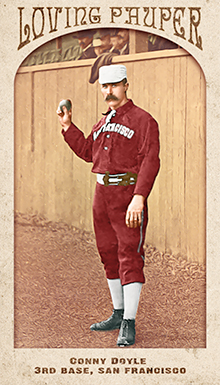- Card series: 1880s: Loving Paupers
- City: San Francisco
- Team: Haverlys
- League: California League
Cornelius J. Doyle (1862-1931) was an Irish immigrant who played outfield for two seasons in the major leagues. He was with the early forerunner to today’s Phillies, the Quakers, in 1883. He had one more attempt at staying at the top of his profession with the Pittsburgh Alleghenys of the American Association in 1884. The AA lasted for a decade following its founding in ‘82. The Alleghenys would eventually morph into today’s Pirates. Conny’s tenure was brief and his stints with both clubs equally so. He saw action in 16 games for the Quakers and 15 for Pittsburgh. He sported an anemic .221 average in his rookie campaign, but finished with a flourish as he hit .293 with the Alleghenys.
Doyle had begun at the pinnacle of baseball, the National League, in ‘83 as a twenty-one year old. His poor batting sent him down to the Northwestern League’s Quincy (IL) Quincys in 1884 where his fine .304 average earned him the next shot with Pittsburgh later that year. He led the Quincys with four home runs playing aside ten other future major leaguers, including Ice Box Chamberlain and Kid Baldwin. Doyle knocked around the minors for the next decade, playing regularly for the likes of the Lynn (MA) Shoemakers, Atlanta Atlantans, Peoria Canaries and the New Haven Nutmegs. In 1889 Conny was captured by photographers in his San Francisco Haverlys uniform during a brief west coast assignment. He closed his pro career with two widely-dispersed teams in 1893: the Dover club of the New England League and the New Orleans Pelicans of the Southern Association. This young immigrant found baseball an ideal vehicle to tour his adopted land.
- At age 31 Doyle was far from the grizzled veteran of the Pelican squad. Dick Phelan was 38 and two other teammates were senior to Conny
- One of those teammates was Kid Baldwin, indicating the twists and turns of pro ball in the 19th century. The Kid and Conny were rookies in Illinois and followed very different routes in their respective careers, but both found themselves closing out their baseball lives with the same New Orleans franchise in 1893
